#cycle 2: upper structure
Explore tagged Tumblr posts
Note
hey spears have you you met any other slugcats before?
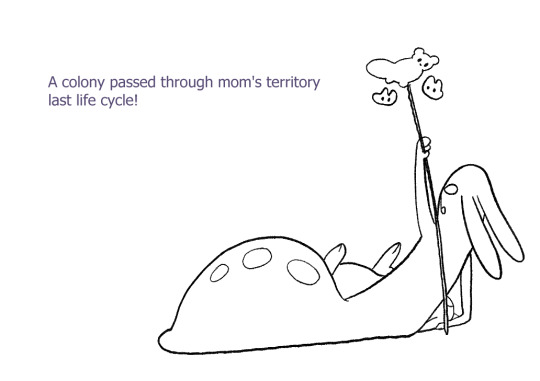
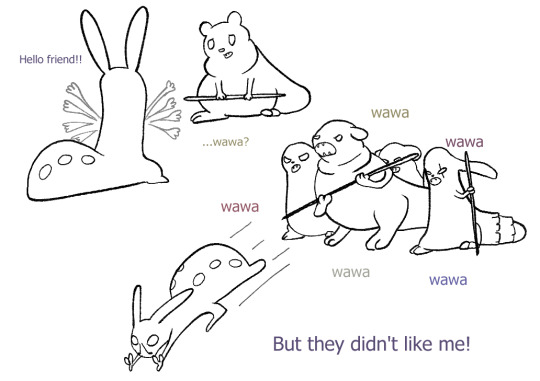
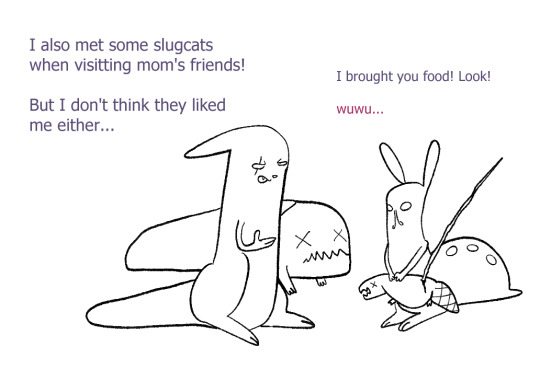
15 notes
·
View notes
Note
So do you have any Silt Verses thoughts that you wish to share with the world?
oh boy! okay time for some buckshot statements
Paige absolute character of all time for being an upper-middle class benefiter of the oppressive class structure who is radicalized and skips right past the "slacktivism on twitter" phase to instead jump directly into "creating gods and killing people." She's smart she's driven she's idealistic she will rend the earth in a horrid symphony of predator and prey ensnarled on bloody oaken crucifixion and I support her.
Hayward does not actually deserve the disproportionate attention I give him and that's because he's a loser and a failure (said with all the love in my heart.)
I may give the impression Hayward is the single fail-man of the series but that is not true. It is actually the case that every single The Silt Verses character is batting between a 50%-70% on the "a situation has occurred and it's gone So Fucking Wrong for them" measure. However Hayward stands out as the single indominable character batting a pure 100% in this category who can never be surpassed.
The voice acting is SO across the board good?? Hayward and Carpenter and Faulkner and Paige would all, in isolation, stand out as examples of excellent voice acting and they're all just together. Also the cameo from Harlan Guthrie in season 2 went so fucking hard.
When I started TSV I was like "oh okay so WE'RE the bad guys. like we're following the disciples of this bloody human-sacrificing river god cult. It's like if the TMA avatars were the main characters." And it was a fascinating revelation for the world to peel back and make clear that, actually, everyone is doing this. The world works like this. The Trawlerman followers are not being targeted for being human-sacrificing cultists - they're being targeted for being the losing human-sacrificing cultists on the wrong side of history. I haven't dug too deeply into this thought but it feels significant in the vein of "MY country's wretched human rights violations are the just and moral ones, because we're the correct people. Unlike those losing nations barbaric and unforgivable human rights violations."
The unavoidable cycle of "I kidnapped you as my hostage but maybe we're fwiends now? 👉👈🥺"
Why did Hayward LARP a whole story about being in a fail-marriage with a fail-wife. Why did he tell all this to Carpenter, a woman he just met. Why is he like this. 💖💖💖💖
Really love Faulkner's brand of "happy little sunshine boy who's being that way precisely because he wants to manipulate you into thinking he's a simple happy little sunshine boy." Very guy-who-killed-his-brother behavior of him.
310 notes
·
View notes
Text
Round 3 - Reptilia - Rhynchocephalia

(Source)
One of the oldest orders with still living representatives, Rhynchocephalia is composed of one remaining species: the Tuatara (Sphenodon punctatus) of New Zealand.
Tuatara are greenish brown and grey, and measure up to 80 cm (31 in) from head to tail-tip and weigh up to 1.3 kg (2.9 lb). They have a spiny crest along their back, especially pronounced in males. They have two rows of teeth in the upper jaw overlapping one row on the lower jaw, a unique feature among living species. Their teeth are not replaced, and as they wear down, older Tuatara have to switch to softer prey such as earthworms, larvae, and slugs, and eventually have to chew their food between smooth jaw bones. They have no external ears, but are still able to hear. Their “main” eyes can focus independently and have good color vision. Tuatara also have a parietal eye on the top of their head, visible only in hatchlings as a translucent patch. After four to six months, it becomes covered with opaque scales and pigment. The parietal eye has its own lens, a parietal plug that resembles a cornea, retina with rod-like structures, and degenerated nerve connection to the brain. It may be useful in absorbing UV rays to produce vitamin D, as well as to determine light/dark cycles, and help with thermoregulation. Tuataras mainly eat invertebrates such as beetles, weta, worms, millipedes, and spiders, but will also prey on lizards, seabird eggs and chicks and, on occasion, smaller tuataras.
Tuataras are more tolerant of, and actually prefer, cooler weather than other non-avian reptiles. They don’t survive well over 25°C (77°F), and can live below 5°C (41°F), by sheltering in burrows and brumating during winter. Temperatures over 28°C (82.4°F) are generally fatal. Their lower body temperature makes for a slower metabolism, and slow growth, taking 10 to 20 years to reach sexual maturity. Females mate and lay eggs once every four years. During courtship, a male makes his skin darker, raises his crests, and parades toward the female. He slowly walks in circles around the female with stiffened legs. Males do not have a penis, and instead mate via a “cloacal kiss”, like many species of birds. Birds and Tuataras are the only reptiles known to reproduce like this. Female Tuataras lay eggs with soft, parchment-like shells. She will lay 9–10 eggs on average, back-fill the nest and guard it for several days before abandoning the eggs to their long incubation period, which takes 11 to 16 months. The sex of a hatchling depends on the temperature of the egg, with warmer eggs tending to produce male Tuatara, and cooler eggs producing females. During their first 2 vulnerable months the hatchlings are diurnal, hiding under logs and stones, to avoid being preyed on by hungry nocturnal adults. Within a year they learn to burrow and become nocturnal. The young Tuatara will continue to grow larger for the first 35 years of their lives. Their average lifespan is about 60 years, but they can live to be well over 100 years old, and possibly up to 200 years in human care,
Despite only having one surviving species, rhynchocephalians were once much more diverse and widespread. They evolved before squamates (lizards), with the oldest record of the group, Wirtembergia, dated to the Middle Triassic (around 238 to 240 million years ago). Rhynchocephalians had achieved global distribution by the Early Jurassic, and were for eons the world's dominant group of small reptiles. Many of the niches occupied by lizards today were held by rhynchocephalians during the Triassic and Jurassic. However, today’s Tuatara emerged in the Early Miocene, around 19 million years ago.

Propaganda under the cut:
The name Tuatara is derived from the Māori language and means "peaks on the back".
Tuatara are the largest reptiles in New Zealand.
Henry, a male Tuatara at Southland Museum, became a father (possibly for the first time) in January 2009, at age 111, with an 80 year-old female named Mildred.
Tuatara feature in a number of indigenous legends, and are held as ariki (God forms). Tuatara are considered the messengers of Whiro, the god of death and disaster, and Māori women are forbidden to eat them. Today, Tuatara are regarded as a taonga (special treasure) along with being viewed as the kaitiaki (guardian) of knowledge.
The eponymous Leo from the Adam Sandler movie Leo (2023) is supposedly a Tuatara. However, he looks more like an iguana and has the tongue of a chameleon. It is also illegal to keep Tuatara as pets, and there is no population in the Florida Everglades. The species may have been chosen to make sure the elderly “lizard” was a long-lived species.
One of the largest known rhynchocephalians was the herbivorous Priosphenodon avelasi. Priosphenodon lived in Middle Cretaceous Argentina and could reach over 1 metre (3.3 ft) in total length. It was the most abundant terrestrial vertebrate in the Candeleros Formation, and the only herbivore found there.
Tuataras are threatened by the egg-eating Polynesian Rat (Rattus exulans), which was introduced to the islands by the Māori. They were wiped out from the main New Zealand islands before European settlement, with populations persisting on 32 rat-free, off shore islands. Attempts to re-establish a breeding population on the New Zealand mainland have had some success. However, climate change may pose a new threat, as Tuatara have temperature-dependent sex determination. Higher egg temperatures lead to males, and as global temperatures rise, more males than females are hatching. Current solutions to this potential threat are to selectively remove adults and incubate female eggs in captivity to then be released.
Tuataras are currently considered “least concern” (ie not at risk of extinction), but their status as a relict species grants them protection and dedicated conservation efforts. Plus, their slow rate of growth and reproduction would make recovery very slow if there is any population collapse. If we lose the Tuatara, we also lose our last living link to an entire order of Triassic reptiles.
#i’m gonna try to make these descriptions shorter but when there’s just one species in the order I do feel like I have to go more in depth#about the species because it may be their only chance to get a spot in the final round#animal polls#Round 3#Reptilia#Rhynchocephalia
101 notes
·
View notes
Text
Wet Beast Wednesday: American eel
It's time for an American creature that is notoriously slimy and slippery. No, it's not our politicians this time, this one actually makes the world a better place. It's the American eel, an eelongated fish with an eelaborate lifecycle. Sadly, human activity has made this once-common critter much more eelusive, to the point it may go extinct. Allow me to eelaborate about this exceellent fish (ok I'll stop).

(Image: an American eel resting on a muddy bottom. It is a long, snake-like fish with a fin running down the rear 2/3rds of the body and around the tail to the underside. There are two small pectoral fins near the head. The head is pointed and the jaws have prominent lips. The lower jaw just out beyond the upper jaw. It it a light brown in color, fading to white in the underside. End ID)
American eels (Anguilla rostrata) are long, slender ray-finned fish of the family Anguillidae, the freshwater eels. It is fairly typical of a member of that family. The body is cylindrical, like that of a snake's and the dorsal, tail, and anal fins have combined into one long fin that runs down the back, around the tail, and along the underside at the rear of the body. They also have a pair of pectoral fins behind the head. The head is pointed, with long jaws, the lower jaw being longer than the upper. Unlike most eels. which have lost their scales entirely, the Anguillidae still have scales embedded in the skin, but they are so small it is hard to notice them at all. The scales grow in irregular rows and do not overlap, unlike most fish scales. The body produces a thick, protective mucus coating. American eels can grow up to 1.2 meters (4ft) and 7.5 kg (17lbs), with females growing larger than males.
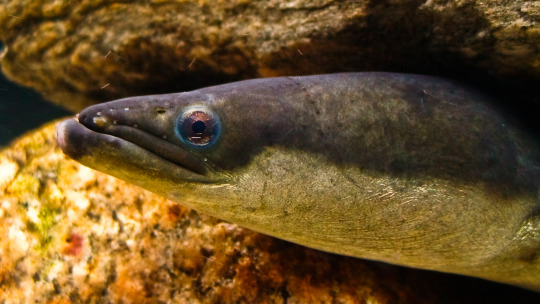
(Image: a close up of an eel's head, showing off the robust lower jaw and the eye. End ID)
American eels have one of the broadest range of habitats of any fish. They live in freshwater and estuaries along the eastern coast of North and Central America as well as northern parts of South America, the Caribbean islands, and southern Greenland. They primarily inhabit rivers and streams as well as and connected lakes and ponds and can range far inland, especially along the Mississippi River. They are predators with a wide diet, feeding on fish, crayfish, worms, fish eggs, amphibians, and dead animals. As with most eels, they are nocturnal and spend their days hiding in burrows or in areas sheltered by rocks, plants, or other structures. American eels are highly mobile and will travel vast distances through their lives. They can move against currents, up slopes, and across wet grasses or short distances of land and young eels are capable of climbing rocks and waterfalls. Some populations will migrate out to coastal areas during the spring and summer and swim upriver for winter. Other populations remain in freshwater or estuaries all year round. During winter, they will bury themselves in the sediment and hibernate until spring.
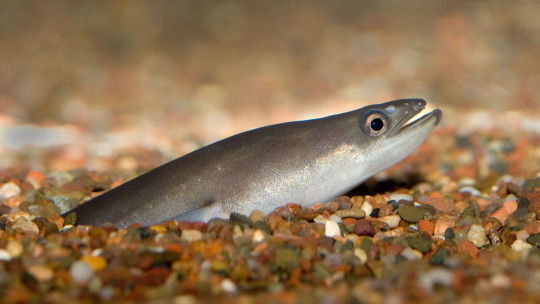
(Image: the head of an American eel poking out of a burrow in pebbly sediment. End ID)
For a long time, the life cycle of freshwater eels was a mystery. They seem to just appear as young eels with no sign of eggs or larvae. Aristotle thought the European eel (also in the family Anguillidae) were mature earthworms and that they appeared out of damp soil instead of reproducing. It was also believed for a long time that they couldn't reproduce as scientists, including Sigmund Freud (yes, that Sigmund Freud) dissected dozens of European eels without finding eggs or reproductive organs. The answer to eel reproduction came later. Freshwater eels, including the American eel, are catadromous, meaning they spend most of their lives in freshwater but migrate out to salt water to reproduce. Sexually mature American eels all travel to the same place to reproduce: the Sargasso Sea. The Sargasso Sea is a unique location in the Atlantic Ocean, a calm location bordered by currents and known for vast amounts of floating Sargassum seaweed. We know that the eels travel in massive numbers to reach the sea and mate all at roughly the same time, but we don't fully know exactly when or were their spawning ground is. They probably mate in massive conglomerations where fertilization is uniform and random, something called panmixia. The eggs likely take a few weeks to hatch and will hatch all around the same time. Large females can release up to 8.5 million eggs. They mate only once and die afterwards, a characteristic called semelparity.
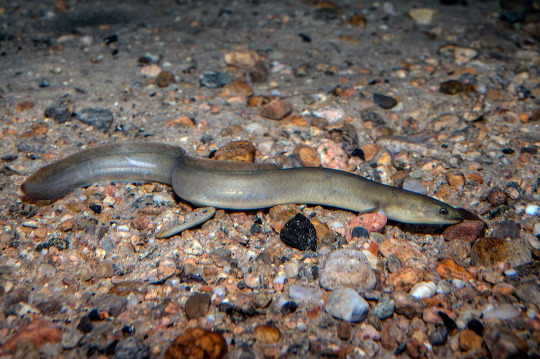
(image: an eel resting on rocky sediment. This one is a darker grey color than in the first picture. End ID)
Eels have a type of larva called a leptocephalus. These larvae are thin and leaf-shaped, with translucent bodies that make them hard to spot. American eel larvae are carried by the Gulf Stream into the Gulf of Mexico and then around Florida and up along the eastern coast of North America. This can take up to a year. Once the larvae are carried over the continental shelf, they metamorphose into glass eels. In this stage, they now take on the typical eel shape, but are still translucent, hence the name. Glass eels gradually grow more pigmented as they move closer to shore. Once they become fully pigmented and move into estuaries and the mouths of rivers, they are known as elvers. Historically, elvers were the first stage that most people were aware of and they seemed to appear from nowhere. American eels remain as elvers for up to a year before they grow into yellow eels, named for their yellowish color that darkens to brown or grey as they age. This is the adult stage, but they are still sexually immature. In fact, up until this stage, they have not even differentiated into males and females. That happens during the yellow eel stage and seems to be influenced by populations. The denser the eel population is in the area, the larger the percentage that develops into males. The reason dissections of eels failed to find sexual organs or eggs is because they were dissecting yellow eels that hadn't fully differentiated yet. American eels can remain in the yellow stage for 10 to 25 years as they gradually mature. Once the eel's life starts to come to an end, it will metamorphose into a final stage called a silver eel. Silver eels undergo physiological changes to prepare themselves for their journey back to the Sargasso Sea. Their pectoral fins get bigger, their digestive tract degrades, the eyes shift to being adapted to a marine environment, the skin thickens to prepare for colder ocean waters, and fat builds up. Silver eels don't eat as they journey to the Sargasso Sea, surviving on fat stores that will last them a journey of up to 4,500 kilometers back to where they were born. Interestingly, the farther an eel travels from the Sargasso sea during its life, the larger it will grow and longer it will live before returning to mate.

(Image: a leptocephalus larva. It is a small, flattened, transparent animal with a tiny head and large eye. The body is overall the shape of a long, slender leaf. End ID)

(Image: a group of American glass eels resting on a yellow surface. They have the same shape as the adults, but are tiny and transparent, with only the eyes, parts of the skull, and spine being a darker color. End ID)
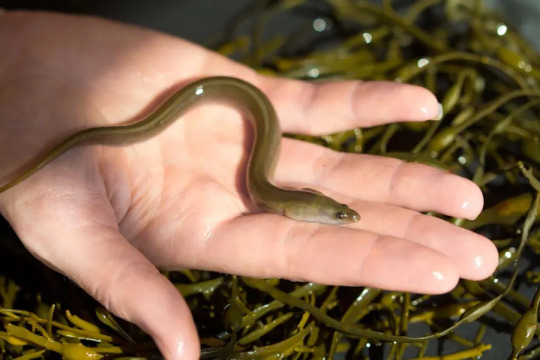
(image: an American eel elver being held in somebody's hand. It is small enough to fit in the palm and is a light greenish-brow color. It has the same body structure as an adult. End ID)

(Image: a yellow eel that has only recently reached this stage, as evidenced by its yellow-green color. It is being held in somebody's hand. End ID)
American eels are classified as endangered by the IUCN, who also described them as being at a very high risk for extinction in the wild. The population underwent a major crash in the 1980s, though it had been declining for a while already. The biggest cause of this decline appears to be dams. Young eels can often cross dams to get upstream thanks to their ability to climb, but adult eels trying to get back out to sea to breed are often blocked. Even if they get past dams, they are highly sensitive to low-dissolved oxygen environments, which waters just below dams tend to be. An eel could make it over the dam just to suffocate at the base. Since yellow eels are more likely to become female in low population density areas, the drop in population is resulting in an abundance of females with not enough males to fertilize all of their eggs. Pollution is also a problem as certain pollutants can accumulate in the eel's fat, then poison it during lean times. Overfishing is another problem, likely just as big if not bigger than damming. American eels have been eaten since ancient times and eel meat is considered a delicacy in many cultures. Because of how complex their life cycle is, American eels can't effectively be bred in captivity and so virtually all eel meat on the market is from wild captures. Eel meat labeled as farm raised is usually actually captured from the wild to be raised in captivity and is therefore not sustainable. Despite multiple attempts to give them legal protection, American eels have little protection in the US or Canada. Eels provide an important service to their ecosystems, being a major predator and food source. They also act as the hosts to larvae of certain mussel species. Freshwater mussels are one of the most endangered animal groups and the lack of their hosts isn't helping with that.
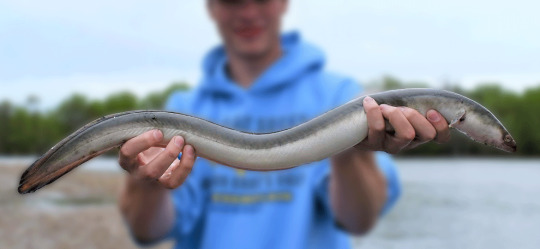
(Image: a mature American yellow eel or silver eel being held up to the camera by a person in a blue sweatshirt. The eel is longer than their arms and a grey color with white underbelly. End ID)
#wet beast wednesday#american eel#eel#eels#elver#glass eel#silver eel#yellow eel#sargasso sea#fish#fishblr#fishposting#eelposting#freshwater fish#estuarine fish#migratory fish#freshwater#freshwater ecology#biology#ecology#zoology#animal facts#informative#educational#image described
95 notes
·
View notes
Text
tuesday again 2/11/2025
the bon mot slot goes to the Witcher comics, bc after i inhaled all of the 2014-present series i realized they scratch the same sad goth detective itch batman does
oops! all books!
adding another axis to the "depressive cycles" graph, where x is "how many minutes of mother mother have i listened to in the past two weeks" and y is "how many books have i read and bounced off in the past two weeks" and brother we're at the extreme upper right hand corner
what was supposed to be last week's gay and/or lesbian romance and/or erotica

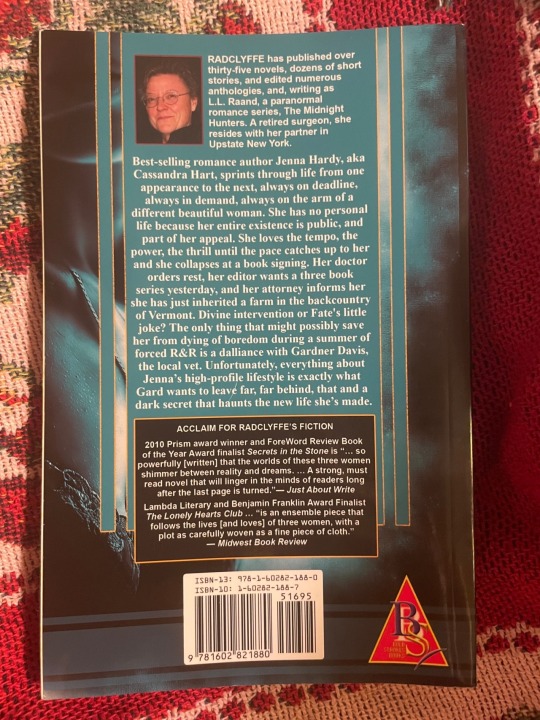
Desire by Starlight, by Radclyffe, is a 261p softcover published in 2010 by Bold Strokes Books. two unrelated facts about this physical object: VERY glossy cover, and smells faintly of mildew despite having a perfect text block with no water damage. radclyffe has written over a hundred books and this is somewhere in the middle. this is sitting at a solid 4 on goodreads with some complaints that she tends to be a little formulaic. i am going to be very honest and say that when i read this two weeks ago, i did not take very good notes bc i didn't love this one. the structure and pacing were mostly fine and there were only a few strange phrases in the sex scenes, i simply did not find it particularly memorable. we have for sure read worse during this project.
i wish the local love interest did not go by Gard, short for Gardner. is it a stupid old money new york name? sure. is it hard to take the book seriously? yes.
i also found it amusing that radclyffe does not follow her own novel-writing rule outlined in this very meta novel: rarely if ever does a scene open close to the heart of a chapter.

the secret our dear gard is hiding kind of fizzles out in the literal last ten pages. i think she should have had a better or more interesting secret instead of one that could be comfortably resolved through a singular therapy session. i also feel that this teetered on will-they-won't-they-let-each-other-through-a-hardened-outer-shell a little bit too long, and the breakthrough was perhaps not as cathartic as i would have liked. this excerpt, nearly halfway through the book, they are still not together. while it's very funny to watch them seethe in poorly concealed jealousy, i am tapping my watch. do something.


i cannot immediately find the weird wording that threw me a little during the sex scenes. the sex scenes are kind of widely scattered.
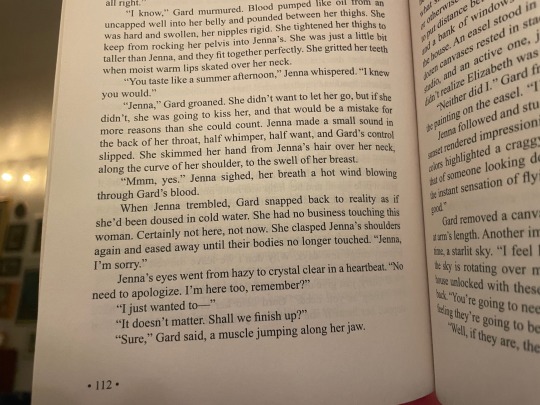
i think the thing that annoys me most about this book is that there's no real benefit for either of them in this relationship. jenna has broken down from not eating or sleeping well on a national book tour, not because she's psychically suffering from not letting see her feelings she keeps in a tightly locked box. there's no real benefit for gard either, who is lonely but not cripplingly so. it starts off as a casual-only thing and then both of them (and me) are startled they catch real feelings.
there are some gestures made toward It's Nice To Have Another Woman Around In Case of Physical Injuries Due To Mishap but i would have loved to see more of how gard was won over by being taken care of. gard princess carries jenna into her vet clinic bc of a fucked up ankle and jenna is annoyed, flustered, and doubly annoyed she's flustered.
i think this one was so forgettable bc i genuinely had trouble remembering what the conflict (if any) was. both of them are stable adults with real jobs and other friends. inheriting a farm in vermont doesn't really add any new or exciting problems for either of them. neither of them are very spontaneous and neither can manic pixie dream girl the other out of her shell, and when they finally do emotionally let their walls down it doesn't feel very organic.
the like technical putting words one after another is there, this is her zillionth book and everyone has dialogue that sounds like things real people would say out loud with their mouths and everyone's physical actions map onto my real-world understanding of how bodies in 3D space work. this one did not grab me.
-
this week's gay and/or lesbian romance and/or erotica
title drops in this book: 3.
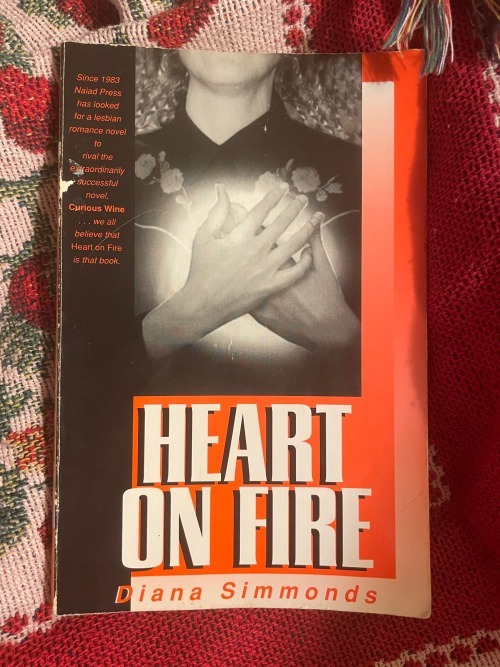
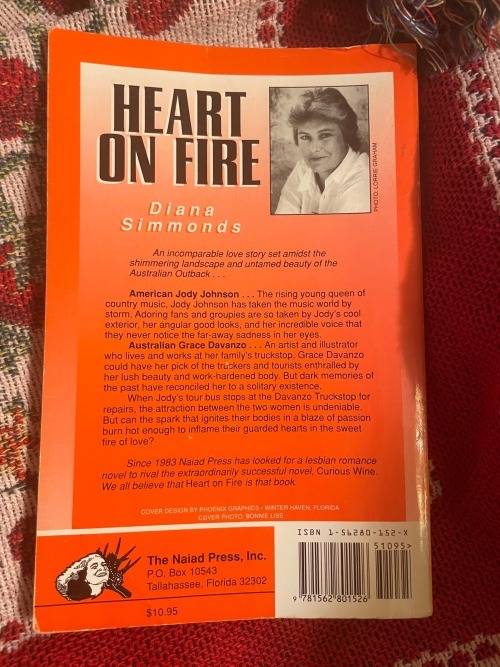
Heart on Fire is a 167p softcover published in 1996 by our old friend Naiad Press. a slightly water-damaged paperback i felt okay dragging down to the gulf when i was dragged down to the gulf last weekend for my health. this was Diana Simmonds' first solo book and first fiction book, and a lot of older lesbians seem to have a great deal of fondness for it. while i was trying to find any press or interviews, most of the hits were from other lesbian authors citing her as an inspiration. naiad really banked a lot on it being the hit novel of their publishing season and were sure it would eclipse their previous bestseller from nearly a decade ago, Katherine Forrest's Curious Wine. i don't own a paper copy but have placed a libby hold so we will make a detour from physical books in the near future.
overall, a rare book where the third act breakup does actually make a lot of sense: being the partner of a globetrotting traveling musician would put a strain on any relationship whether you choose to stay on the road or wait at home. however! it really did stick the landing! and for that i can forgive it a great deal! the sort of not quite reality of their respective third act depression sojourns and then the incredibly sensory descriptions of the finale concert…very good. very nineties movie about a musician ending if that makes any sense.
while i think the structure is fine, i think the actual craft of the narrative is more variable. we'll go into the style in the next paragraph, but part of the dedication goes "to CCC, without whom it would be full of people thinking to themselves." i wish CCC had dialed their feedback back a little bc i would have loved some more interiority, particularly from jody. i must commend our stuck-in-one-place half of the couple, grace, who makes SUCH fascinating decisions. the traveling musician jody looks like she could be the sister of her abusive ex-husband, grace's brief rebound from jody is her goddamn college advisor… bonkers. what ARE you doing???

stylistically, it feels like sitting on the patio of a lesbian bar for three hours and listening to a friend telling you a very long story about how two absent friends you don't know got together with a lot of elaborations and asides. i occasionally found this style tiresome. there are some charming turns of phrase, like "She wrote the address of the roadhouse on the package, sealed it with a kiss, said "What the hell," to neutralize the sentimental gesture, and dropped it into the mailbox." i also cackled out loud at "I don't know, I-- I really really want you, so much, and I am not very good at being cool about it." did nearly tear up at this paragraph:

some things have aged a little strangely since 1996. grace is briefly forcibly kissed by a very drunk bandmate before jody rescues her, but there are further instances of someone not immediately stopping a kiss or an embrace or what have you when someone else says no, that i think could not be written in a modern day romance novel. there are some very frank discussions of marital abuse right after a literally soul-healing sex scene.
this is a book that could never be rewritten as a straight romance with light serial numbers filed off. no one is in physical danger just because they're gay, but there's a lot of internal homophobia and readjustment on grace's part, and overall people are fairly accepting in theory but not always in practice. jody outs herself to the aussie press, and early on/right after her bus breaks down, grace and her mother discuss this news and her mother tells her off for being prejudiced, but connives to throw them together to distract grace from her recent divorce. her mother is then is very sad about the thought of her daughter who would have a very difficult life as a publicly out lesbian, and I can’t really blame her, but it’s such a switch from the vehement Fix Your Heart Or Die!!! discussion in the second chapter. there are some fraught familial reactions to grace's bisexuality-- her mom basically bullies her dad into remembering he loves his daughter-- but they all do come around.
this was fine and a good beach read, i'm not sure that i'll ever reread it. almost forgot about the sex. i think the current fashion for queer romance novels is not quite as purple, but the whole book is like this and i must respect an author's full commitment in this manner. here are some sex examples on non-consecutive pages.


-
did not finish, or finished with severe annoyance
i have become a libby power user in my old age bc texas is remarkably free with its library cards. i don't THINK i'm meant to have five of them but there seems to be no law against it and no one's told me to fuck off? this is good bc i have (at the moment) 44 holds and 56 "notify me if any of my libraries purchase this book" books tagged.
the flipside of being willing to give anything vaguely intriguing a try is that most books aren't very good or they aren't quite what i want. i will DNF anything, anytime, for no good reason. i know that statistically most novels are debut novels but i am so fucking tired of reading debut novels.

Hammajang Luck, by Makana Yamamoto, debut novel published last month. comps include ocean's 8, blade runner, and gideon the ninth. much as i love a heist novel, a heist is extremely ambitious for a debut and i didn't quite vibe with the style. i DNF'd at around the end of chapter seven, it has a very strange issue where we get from location to location pretty snappily but overexplain setting and clothing too much within individual scenes. i think it wants to be a screenplay a little too bad. a great deal of the dialogue is hawaiian pidgin (what the author grew up speaking). very much a me problem, i didn't have any experience with this language coming into this book and it was hard to turn off the kneejerk "this is racist and making fun of black people" response i had. again, very much a me problem.
Yamamoto uses Hawaiian pidgin—“an amalgamation of Hawaiian, English, Japanese, Chinese and Portuguese”—in much of the novel’s dialogue, particularly between Edie and their crew members. It is the “primary language” spoken on Kepler and speaks to the kinship between the characters. However, the decision to include pidgin occurred by happenstance. When writing the first line of dialogue between Edie and Cy, fellow crew member and friend, “it just came out in pidgin spontaneously”. Yamamoto “tried to rewrite it in standard English”, but it “sounded wrong”. Notably, the pidgin and Hawaiian words in the novel are not italicised or translated, nor does the novel include a glossary of terms. Yamamoto felt that these practices were “othering” and so asks the reader to do the work.
i think this is a reasonable thing to ask a reader, and i think i might have to take a crack at it some other time.
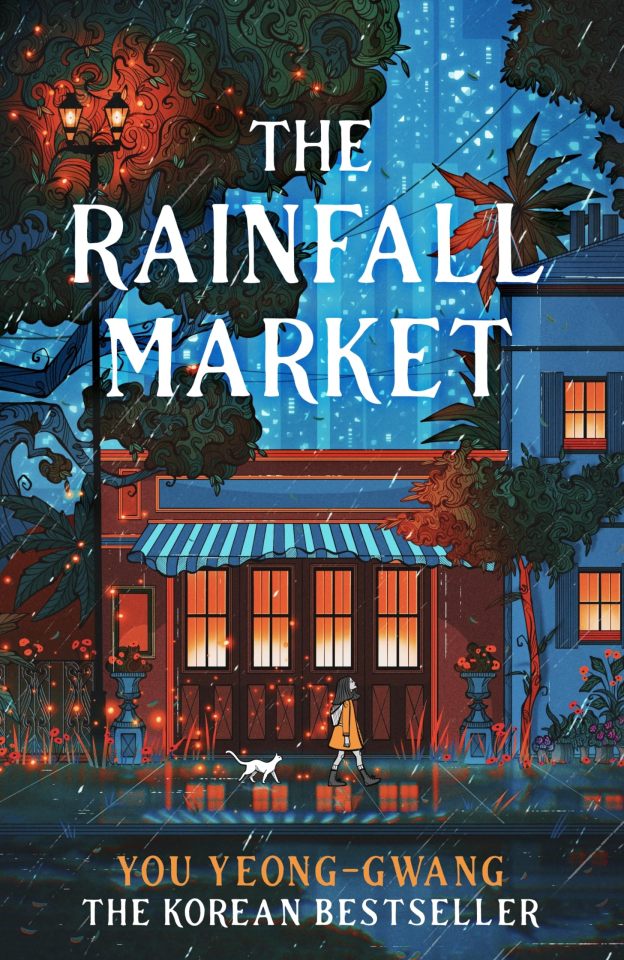
The Rainfall Market, by You Yeong-Gwang, a debut novel from last year freshly translated from Korean. a young woman wins a lottery ticket to enter the Rainfall Market on the first day of the rainy season, where she can completely change her life. DNF at two chapters. this seems to be generally marketed as general fiction (which is what my library had it under) but it feels very middle-grade, both as far as sentence structure and vocabulary and the general maturity-- the protagonist is about to graduate high school but her concerns and goals feel more like she's about twelve. not sure if it's an unfortunate series of translation and marketing decisions? rough!

Water Moon, by Samantha Sotto Yambao, the author's fifth book and published last month. the premise of this book is so charming: liminal-space pawnshop where you can exchange your regrets for tea, woman taking this family business over from her father, physicist who stumbles in, oh no! the physicist is playing the scully to her mulder but does not have a physicist Vibe. i think he’s too personable and not tiresome and mansplainy enough to be a particle physicist. he's too nice. she falls in love with him near-instantly. DNF partly because i have never met a particle physicist i could stand to be around for more than fifteen minutes, mostly a DNF bc at about a quarter of the way through this very slow to start book, when the girl turned to the boy after they fell through a pond into a perfect recreation of a edo-era tokyo street and said "this is the other world, you can call it isekai" i did not throw my elderly ailing phone across the room and i did not get up and stomp around bc phil was on my lap but i did vehemently return the library ebook thirteen days early.

Lucky Red, Claudia Cravens, a debut novel published summer 2023. this thoroughly fucking annoyed me. published by the literary group that also ran...basically a budget MFA? they called it a "novel generator in 12 months", they have since closed, and i cannot find how much AI was involved. i do not think this book was marketed well:
A thrilling, raucous, and gloriously queer debut about a scrappy orphan bent on making her own luck in the American West—and finding friendship, romance, and her true calling along the way, now in paperback.
this book is about an older teen in 1877 dodge city who turns to survival sex work. terrible thing after terrible thing happens to this girl whenever she makes a connection outside living just in her own head and for what? it felt like the author was setting up to deliver some moral lesson or theme other than "never question your boss" but never quite followed through. it felt like the author was punishing the protagonist for being a whore even though that’s the book the author chose to write and the author can't quite decide if it's empowering or not. again, it's very strange to read a book where the protagonist is punished for almost every decision she makes and very few parts of sex work are idealized, but then she turns to the camera and reassures the reader with a chipper "but it wasn't all bad!". i wish the protagonist got to mature or grow as a character a little more. i think this could have used more time in the oven and an ending that doesn't feel like a very ill-earned end of every american western ever. thank fucking god this is a real ensemble cast and not found family or i would be much more impatient with this book than i already am.
good at getting me to finish a book bc it's very effective at hustling you from chapter to chapter. great technical skill on that front. bad at any sort of emotional throughline.
things i DNF'd after less than two chapters

Thornfruit by Felicia Davin, published in 2018 and her seventh or eighth book. i am a little annoyed bc this was on hold for over two months but i really do appreciate the AO3-style list of tags and warnings in the front bc now i know there is stuff in this book that is not for me!
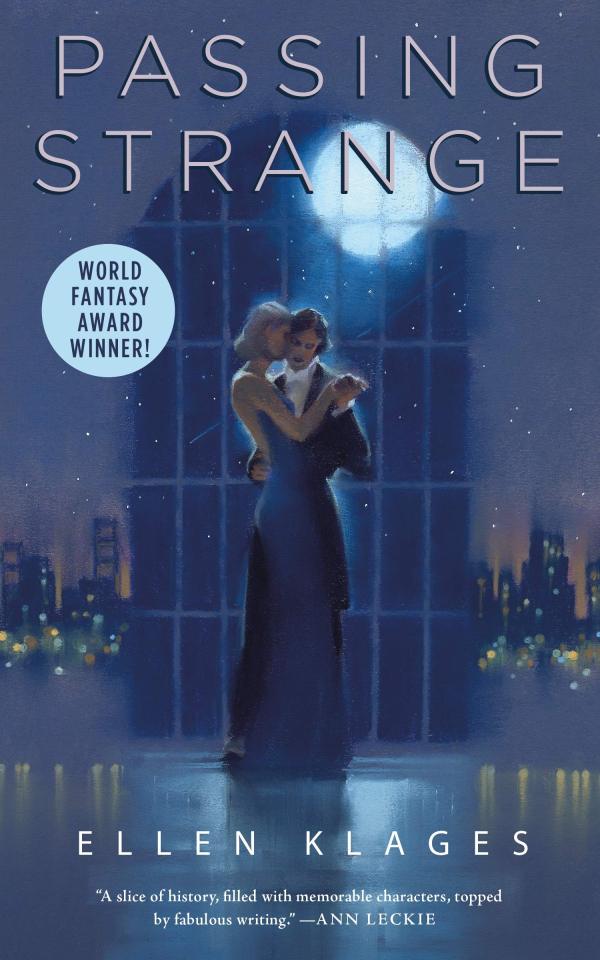
Passing Strange, by Ellen Klages, a 2017 novella and her...twentieth? work. a prolific woman. urban fantasy gay historical fiction of 1940s magical san francisco. while i do love a magical painting, i did not have it in me this week to read about a woman struggling with her legacy in the face of a terminal diagnosis.

Nevernight, Jay Kristoff, 2016 first book of a trilogy and his third trilogy overall. he keeps fucking getting me with fun vampire premises but he's very much in the same bucket as paolo bacigalupi in my brain. far more brutal and visceral things happen than you really are prepared for. do not love an opening chapter with disassociation to a past sexual assault in the middle of an assassination, as movie-crisp as the match shot transitions from present day to disassociation were.
plus a nice half dozen varied romances im not going to individually name, bc the last time i seriously used the "tag for later" feature in libby was the summer of 2019 and my tastes have changed. for example i rarely put myself through heterosexual vampire romance books these days.
-
yeah these were all right

Red Harvest, by Dashiell Hammett, his first full novel in 1929 after literally dozens of shorts and novellas. this detective noir was like watching a car crash. brutal little book. im positive this is not the earliest example of turning both ends of a town against the middle for your own profit, but it was the one cited for yojimbo so its the one that gets brought up a lot. i think the cast is slightly too large for what hammett is trying to do. sometimes reading noir as something woman-shaped feels like an elaborate act of self-harm.
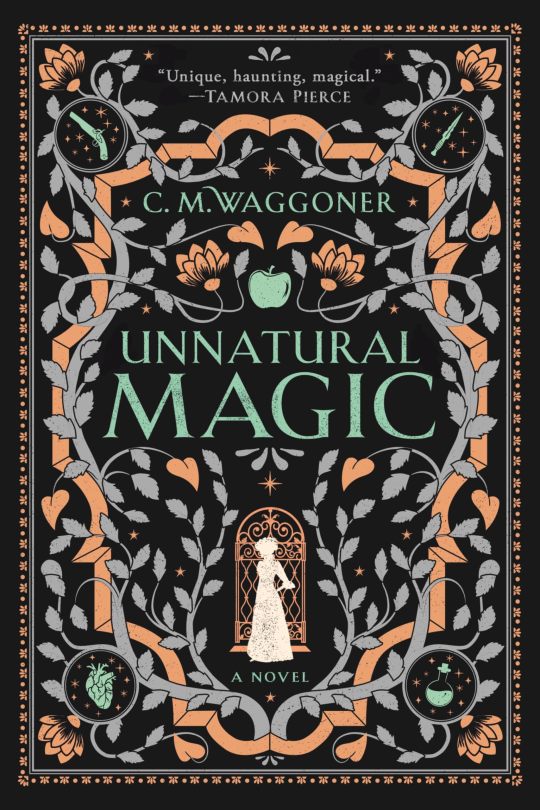
Unnatural Magic, by CM Waggoner, a debut novel from late 2019. thoroughly charmed by this one! one of the most well thought out country/species/religion/immigration systems and how any and all of those can impact any one specific wizard’s magic. it's like a beautiful clockwork orrery ticking along in the background. very prachett-esque approach to troll gender. the baddie is Not doing good things but the ultimate motivations are really understandable! I get why that happened even if it was a really bad reaction! a line i keep turning over in my head is "worry like a third person in the room." i have put their second book on hold on the strength of this one.
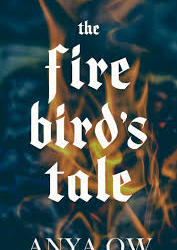
The Firebird’s Tale, Anya Ow, a debut novel from 2016. charming retelling of the fairytale element of a royal having to marry the one who makes him smile. the lead up to and the third act separation itself were kind of stupid, and felt like it wanted to be a duology but wrapped up very fast. has a lot of thoughts about choice and putting the end of things to bed quietly and with dignity on your own terms. also has a lot of thoughts about meanings of stories. the non-magical and non-immortal half of the couple is a possessive prince who falls so hard so fast and is mad about it. they fuck so many times while thinking "well surely this doesn’t mean anything, we're just married for the convenience". they're both so dryly exasperated.
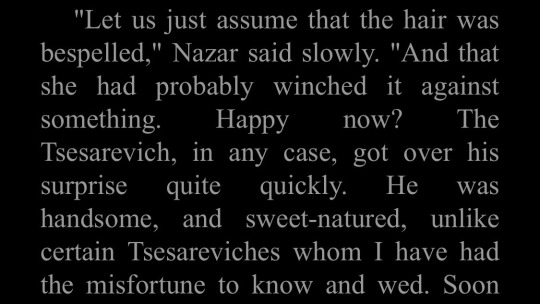
-
there's an additional hardboiled noir that was fun but i have nothing particular to say about, and a stack of physical comics from a new library that i mostly hated, but we are almost at the image limit and it is 1030 PM. i can't see why we wouldn't be back to the usual format next week but no promises bc there are no rules
27 notes
·
View notes
Text
Kiln step 2 :

Finished basically the red parts:

(Karkanas et al. 2019. Microstratigraphic and mineralogical study of a Late Bronze Age updraft pottery kiln, Kolonna site, Aegina Island, Greece. Archaeological and Anthropological Sciences.)
The greyish brown is not concrete it's muddy clay mixed with a tiny portion of special chimney cement i had left from years ago. It is not used as structural support so it should be fine:)
The chimney is going to be so annoyiiiing to do:( I'm almost out of bricks so i decided to build the chimneys out of air dried clay mixed with a mush of bamboo fibers (i don't have hay lying around but i do have bamboo)


I would like to be able to have a final elevation of the upper chamber of approx 30cm but i may not reach that. We'll see.
Furnace step 1 :
I also started working on the adjacent bronze furnace.



Simpler construction, this is not my first but it is the first one that I'm designing only to function as a melting furnace and not also a forge so it can be square:) These are foundations stacked on top of a simple pit. I don't think i will leave the steel tubing past the first firing cycle .
When the chimneys for both of these will be drying I'll start building the forge which is the simplest of the 3 structures and will require less than 3 h of work.
11 notes
·
View notes
Text
Fathers in societies with exclusively masculine origin symbolism are distant, controlling figures who are inactive both in the care of infants and in the socialization of young children. The Amhara, for example, trace their origins to the magical actions of a Supreme Being. It is the Amhara woman's job to conceive and the man's job to control and dominate. For the first 2 years, the Amhara baby is never out of touch with the body of the mother or some other woman. Fathers rarely fondle the baby until it is weaned. After this it is only a "special occasion" when the father lets the infant ride on his shoulders. Fathers, whether natural or adopted, expect complete obedience from their children. It has been said that "reverence for one's fathers is perhaps the key legitimating principle in the structure of Amhara morality. This is the outgrowth and foundation of a social system which makes children devoted servants of their fathers and keeps men under their fathers' control until they are fully adult." Amhara men consider all women to be biologically, intellectually, and morally inferior. Amhara women, however, do not necessarily accept this judgment. In the case of some types of women, such as upper class or older women, men admit that their judgment concerning women may not be valid.
Suspicion, competition, sexual antagonism, and rigid sexual segregation characterize many of these societies. The disassociation of the father from children is in large part a disassociation from women. Masculinity and the male collective are often well developed. Among the Comanche, masculinity is expressed through the military complex, which colors all tribal values. Comanche law is described as a struggle for status among individual males. Competition for "bravery ranking" is a major male pastime and includes, among other things, stealing women from their husbands. Males are too busy proving their maleness to spend time with children.
The Azande are not much different. The person dearest and most loved by the Azande male is himself. The Azande are jealous of skill and talent, competitive, and frequently suspicious that witchcraft is working against them. Family life is characterized by the inferiority of women and the authority of elders. Women play no part in public life and are looked upon as childbearers and servants. The father exercises great control over his sons, who treat him with the utmost respect. Daughters are considered inferior beings, not to be admitted into companionship with their fathers. They are part of the background, where they work and eat separately with the female members of their father's household.
The cycle for Mundurucu babies is one of initial total dependence on the mother, followed by a period of care by several women, displacement by a new sibling, and the awakening of interest by the father. Mundurucu fathers show little or no interest in their children until they are able to walk. Very little solicitude is shown toward the mother, who is considered to be in a state of social marginality from the onset of labor until a few days after the child is born. This is because children may be stillborn, deformed, or may die after only a few hours of life. Infanticide is practiced if children are born with serious birth defects and if twins are born. Since animals have multiple births, twins are killed, because it is believed that they are a reversal of man's differentiation from animals.
To summarize, in most cases in which fathering is absent or barely stressed in behavior, maternity is absent in the projection of the beginning of things. The nurturant father, on the other hand, is buttressed by the female creator. In these cases the reproductive functions of women are celebrated both in myth and behavior. In the absence of the female creator, fathers are involved with children in infancy and early childhood either as disciplinarians or not at all. When their major role is to discipline and control, fathers are not unlike supreme beings. They are distant, controlling figures who are removed from biological processes.
-Peggy Reeves Sanday, Female Power and Male Dominance: On the Origins of Sexual Inequality
8 notes
·
View notes
Text
weekly roundup
listening
FATT: introduction to realis and then episode 1 of the realis miniarc. I like it! this is a very Made By Austin Underscore Walker ttrpg for sure
Lady of the Moon (Night Cap) - very lush
Sun (Serik Fein) - sun drenched rocks
The Only Exception (Paramore) - good to sing along to, might have boyf learn guitar for it
and then the following for orchestra:
Tchaikovsky No. 4
Bruch Violin Concerto No. 1
Overture to Nabucco
reading
finished the dispossessed - literally obsessed. so fucking good. as a physics phd student I really enjoyed the pseudophysics, the callout to "Ainsetain" made me laugh. felt very big brained when I connected the structure of the book (alternating chapters of his timeline, with the last chapter leading back to the first) to the metaphysical ideas of cycles and non-linearity of time... started medieval haggadah book
i won't be going gentle (cyanocorax): really cool fic. what if odysseus was a trucker.
watching
finished the Lain rewatch w the boyf. really good. got to mutually infodump on gnosticism. pepe sylvia string board moment. we also watched Space Patrol Luluco! really cute. the references to the other trigger shows made me laugh.
also got him to watch the first ep of the tgcf donghua. I forgot how opaque it is for people who aren't already initimately familiar with the characters and story lol...so I do not think we will be watching more :(
playing
dnd!
making
painted koi on a plate!

painted some ferns on some sake cups for my mom! this and prev are both majolica-style so I hope they come out of the kiln the way they went in and don't turn into a muddy mess…

finished bug coasters! they are not big nor flat enough to really be coasters but I can hang them on a wall, put them in flower pots, prop them up on a bookshelf…many options.

eating
crispy pan fried shrimp with cabbage slaw (12ft.io will bypass the paywall). yummy! used freezer brown rice instead of farro or whatever. doesn't reheat the best, I have just been reheating the rice and not the shrimp but they are no longer crispy. toaster oven might do a better job.
chicken rice with buttered onions: another broadly-W from deb smittenkitchen! I couldn't find bone-in skin-on thighs and I did brown them because I didn't see her note beforehand about skipping the browning step for skinless boneless so they ended up a smidge dried out...I have some leftover harissa sauce from my other chicken recipe in the freezer so I think I am going to defrost that to have with the thighs. the rice is really good tho.
moving
feb 17: row (70lb 3x7 with a wide grip, 1x7 with a narrow grip), lat pulldown (70lb 3x5), bent over cable row (15lb 2x8 each side), and then 20 min on the elliptical (3 min with resistance, 2 min without, repeat)
last gym visit before that was feb 4 :( the mental illinois was Quite bad last week, had a really bad time getting myself out the door... 1 hr 15m, lat pulldown (70lb 3x5, 85lb 3 2), shoulder press (20lb 5x5), incline biceps (12.5lb 3x7), tricep pulldown on pulley (25lb 5 7 5), upper lats (28lb 3x5), arnold press (7.5lb each 5x8), cable bent over row (21lb 8 5), 10 bench pushups
misc
it's been a rouuuughhhhh two weeks. no other comment.
2 notes
·
View notes
Text
Jockposting :) Lifting progress under the cut 💪
the tldr is that i a couple of months I put 20kg on my deadlift, 15kg on my squat, and I am SO close to benching 35kg for reps I can taste it. If I was in a frame of mind to optimise for recovery and nutrition I'd be unstoppable but as it is I'm just really feelin' myself
I'm on week 9 of GZCLP, a reddit-bro sorta program that's IME extremely effective. Once again, I maintain that reddit is phenomenal for solid fitness knowledge
It's a linear progression program, meaning that you increase the weight on the bar week by week, and it's ideal for novices who're still in the "beginner's gain" stage of weightlifting. It's also great if you're returning to structured programming lifting after a break (me!) but I probably won't keep at it after the first 12-week cycle is over, there's only so much linear increase I can aspire to.
Programming: GZCLP is 4x week, built around big compound lifts in the "strength" range (low reps, higher weights). They're complemented by a medium-rage amount of reps of a different compound lift than the one you're practising that day. So basically, you do big lifts twice a week, but at a different weight/range (called Tier 1 and Tier 2 to tell them apart). Every session also includes isolation exercises in the hypertrophy range, starting at 3x15+.
Jargon: that + symbol means that the last set is meant to be "as many reps as possible" or AMRAP. So if I'm doing 3x5+ squats, I'd do 5 reps for my first and second set, then try to aim for 6 or 7 in my last set.
Progression: You add weight every week to each compound lift; if you fail, the rep scheme changes keeping the volume the same.
T1 (main lifts) go from 3x5+ >>> 4x4+ >>> 5x3+
T2 (medium range reps for compound lifts) start at 3x10 >>> 3x8 >>> 3x6
T3 (back work and accessories) are 3x15+, only progressing when the AMRAP set gets to 25.
The T2 lifts especially are brutal. Because they go up every week but the amount of volume is A Lot. Doing sets of 10 reps with heavy-ish squats or deadlifts is extremely demanding.
Sessions! Basically, each week looks like this
Day 1: Squats (T1) + Bench press (T2) + Back work and leg accessories (T3)
Day 2: Overhead barbell press (T1) + Deadlift (T2) + Back work and upper body accessories (T3)
Day 3: Bench press (T1) + Squats (T2) + Back Work and upper body and core accessories (T3)
Day 4: Deadlift (T1) + Overhead bar press (T2) + Hip thrusts (T2) + Back work and core accessories (T3)
I start every session with dynamic stretching AND core engagement exercises (deadbug, planks, renegade row, suitcase carries) and usually end with an abs + kettlebell swing circuit. KB swings are SUPER FUN, btw. I do them every minute on the minute with a timer, starting with 5 swings then working my way up to 12-15 reps on the minute before I go up in weight. Currently I'm using a20kg (44 lbs) kettlebell.
💪 Weight on the bar! ✨
The whole point of this post was to blather about my lifting numbers so here we go. I started 9 weeks ago a bit conservatively, which imo is better than starting too heavy and going up too fast. I've failed every lift except squats, and that's only because I'm not consistently breaking parallel like I want to — a goal for my next training cycle is to work on lower body flexibility, go lighter on squats and with better form. This cycle is mainly to get more weight on that bar.
Squat
T1: 37.5kg >>> 52.5kg (116 lbs) for 3 sets of 5 reps
T2: 32.5kg to 43.5kg (96lbs) for sets of 10 reps
Overhead press
I failed multiple times here! Why is it so hard to build stronk shoulders, I ask you
T1: 17kg to 22.5kg (50 lbs) for 4 sets of 4 reps
T2: 12kg to 18kg (40 lbs) for sets of 6 reps
Bench Press
Veeeery proud of how this one is going
T1: 25kg to 33.5kg (74 lbs) for 5 sets of 3 reps
T2: 20 kg to 30kg (66 lbs) for 3 sets of 8 reps. Veeery proud of my progress on this one.
Deadlift
Bit frustrated because DLs used to be my strongest lift and I feel like I should be further ahead but that posterior chain needs nurturing
T1: 43kg to 62.5 (134 lbs) for 5 sets of 3 reps
T2: 33kg to 53.5 (118) for 3 sets of 10 reps
What's next?
3 more weeks of GZCLP then we shall see! I'm thinking an intermediate bench program + less volume on lower-body lifts, especially since I'm going to get more serious about half marathon training next month.
#jockposting#exercise#this is for accountability but also for my fellox flexin lesbians of tumblr dot com#elle.txt
19 notes
·
View notes
Text
First post WooHoo
Thought of some vulture stuff for Rain World that would be cool for a mod or smthn
First up are Vulture Fledglings: Young Vultures that aren't as good at flying, but make up for it with ground speed and persistence. They aren't as good at sudden entrances as they're larger, darker colored elders, making their shadow clearly visible in the background for several seconds before arriving on screen. Once they identify prey (or simply wish to stretch or play), they drop to the ground upon their wings and reveal a high run speed, being slightly slower than miros birds, but also a bit smaller, giving them their most terrifying ability. They can move through pipes, meaning they can follow you indoors and possibly into shelters. They chase prey in hopes they are either slower than them, or that the prey will make a mistake. This persistence comes at a cost however, as they tend to grip anything in front of them with their wings to propel themselves forward and also get pretty bad tunnel vision. Ambush predators such as Pipe Plants, Dropwigs, Stowaways, (to an extent) Worm Grass and camouflaging lizards easily snack on them and with gusto, as the Fledglings are big enough to be a hearty meal and small enough to fit in a den. There could possibly be king variants that need to stand still to use their harpoons.
But that's not all I've got for vulture ideas, i also have an idea for an area centered around them
The Nest, as i'm currently calling it, is a tall structure standing taller than the communication arrays, ranging from in the clouds to even above them, and is where all the vultures go to nest after hunting lizards and scavengers. It is essentially a vulture-centric version of Metropolis, being a difficult late game area centered on one enemy. It would be separated into 2 halves: The upper half above the clouds and the lower half nestling deep within them.
The upper half is where the adults stay, using The Nest as a vantage point to watch over the land and plan hunts. It can get rather windy up there, flinging loose items and even smaller creatures clean off into the distance (Slugpups beware). Miros Vultures can spawn up here, but are quickly chased off by king vultures, being shunned as bastards. Even rarer is the appearance of Centiwings, which are quickly swarmed by vultures looking to keep them away from their young and to grab a quick meal. Pearls in this area reveal that vultures wear masks to ward off rival groups as they are highly territorial, to the point of killing those they cannot identify.
The lower half is where the young stay, taking cover inside the structure from the weather conditions within the clouds. The dense clouds causes a strong fog effect, making it too dangerous to fly, perfect for fledglings who prefer running over flying. There is also a small centipede population. Pearls in this area reveal that before being claimed by the vultures, The Nest used to be a Meteorological Array used to research the steadily worsening storms. It consequently was heavily charged with static electricity, which centipedes guzzled at greedily before the vultures showed up.
Cycle endings are also quite unique here. Normally it starts raining to the point where everything not in a shelter is washed away, but how does that happen above the clouds? The answer is another question.
Where did all these vultures come from?
Mama Bird starts her patrol at the end of each cycle, making sure The Nest is pest free for her children. This queen vulture is almost double the size of a regular vulture, and about that much more deadly, relentlessly chasing you and slinging harpoons in an aggressive attempt to either kill you or drive you off the tower. However, she cannot reach the lower half of The Nest on account of being too large to fit indoors and the poor flying conditions within the storm clouds.
While there is a drizzle, rain is not the main end of cycle threat in the lower half. Lightning strikes the area constantly, attracting many centipedes and possibly striking you. The electricity also gives some power to the Array via numerous lightning rods, causing flickering lights and jittery machinery as everything receives and loses power repeatedly. Combined with heavy winds causing the structure to lean, possibly sending you out of windows, and getting to a shelter is highly encouraged.
Shout Outs to @dustyfandomtrashbin for encouraging me to post about my ideas and getting me into Rain World in the first place. Holy Slugcat (Saint) is this game fun to talk about.
30 notes
·
View notes
Note
Suns how has eating been like, do you have a favorite food yet?
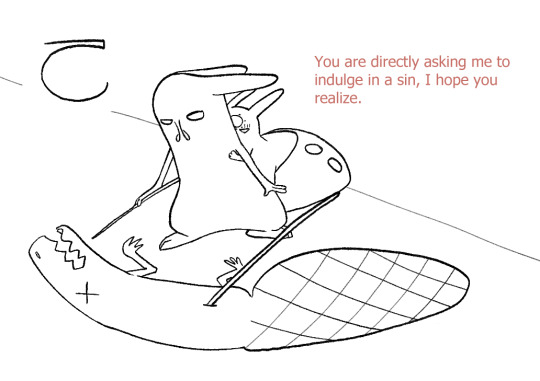
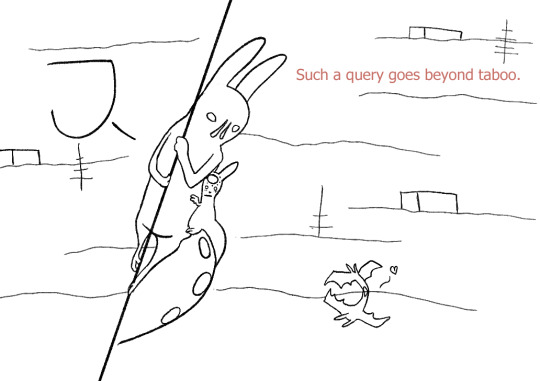
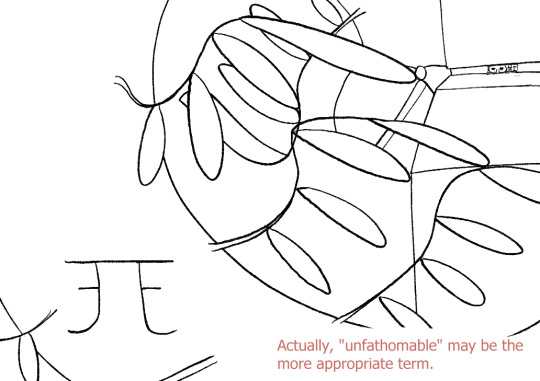
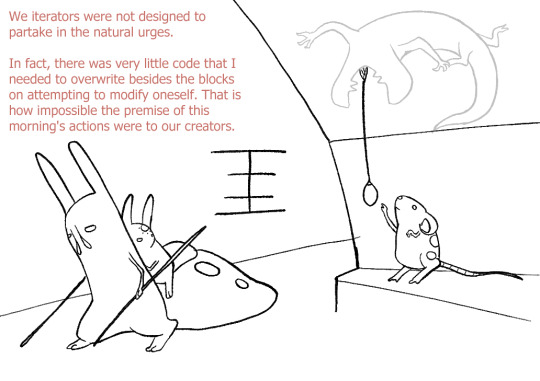
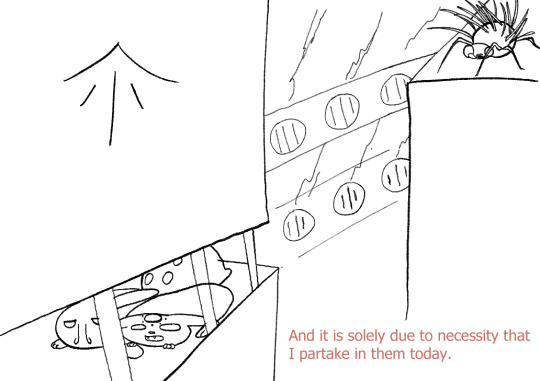
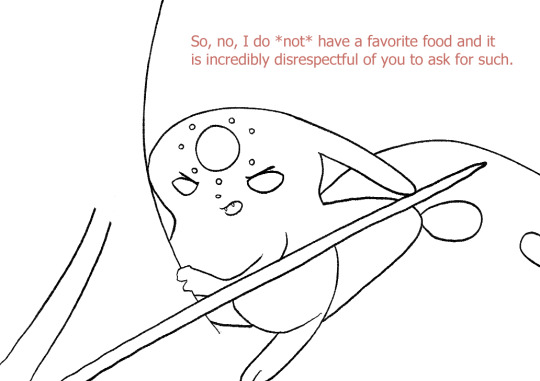
#you have angered the tiny god with your ~distasteful~ inquiry#truly they cannot ~stomach~ such nonsense#auroraxcros#ask#seven red suns#spearmaster#rain world#cycle 2: upper structure
9 notes
·
View notes
Text
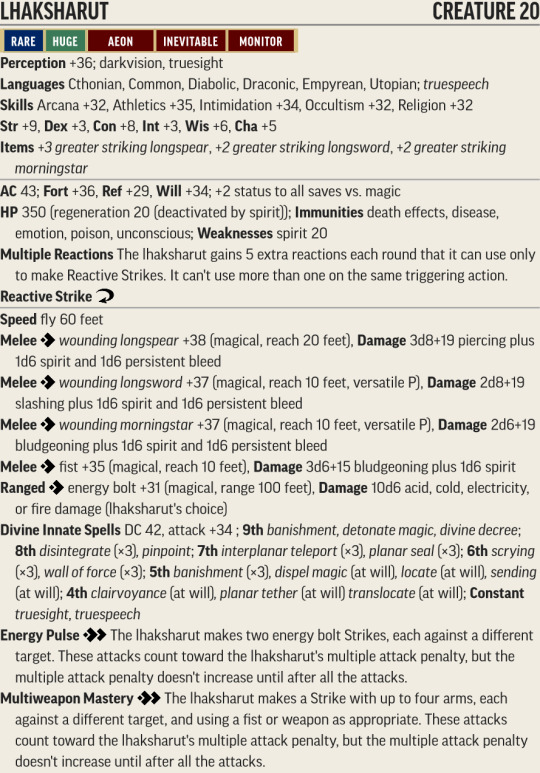
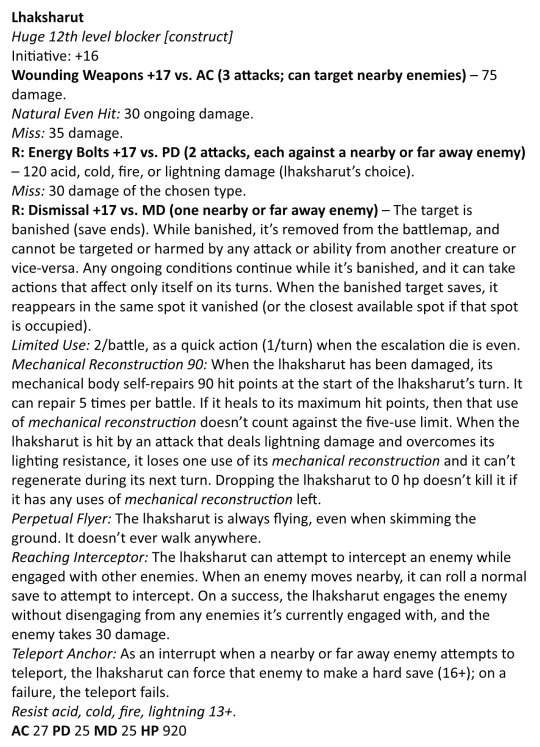
The most powerful of the known inevitables, the lhaksharut is a massive, looming figure. A humanoid upper body made of stone, with six arms and metal wings, rises from a collecting of interconnected, spinning metal rings. These wings aren't the source of the lhaksharut's flight, instead stabilizing and bolstering its agility. Very few of these immense extraplanar constructs exist, as the factories that produce inevitables must spend many, many cycles on a lhaksharut, time that could produce dozens of lesser inevitables, so they are built sparingly. They are also expensive to equip, typically carrying three to four powerful magical weapons with which they fulfill their duties. Four of the lhaksharut's arms are usually armed, while the last two (the lowest) carry metal spheres that crackle with energy that it uses to launch bursts of energy.
What are these duties? As with all other inevitables, lhaksharut are built with a detailed list of rules for a specific factor of existence and police the status quo as outlined by their creators, and for the lhaksharut it's the stability and separation of different planes. Travel between the planes is of no concern, but perpetual gates, or attempting to rip a portion of one plane to another must be addressed wherever it is found, and the lhaksharut's method of dealing with such issues is very simple and straightforward. It will smash and destroy any person or object involved in such an issue without a concern over the specifics. The reasons for the infractions do not matter, but rarely they can be negotiated with. They are dogmatic and strict, but not completely mindless, and if presented with a greater threat that may require a temporary open gate, it can defer momentarily to resolve the greater planar threat. In such a rare situation, it will find a compromise in standing guard over the gate, prepared to destroy it as soon as the larger situation is resolved.
Lhaksharut typically work alone, like other inevitables, though they will have some kind of information network to update them on major planar issues. These kinds of threats are rare, either well hidden or coming into existence under extreme confluences, so much of a lhaksharut's time is spent in wait. Some create strongholds, others just find a deep void and meditate within it, but all are ready to spring into action the moment they are made aware of a planar breach of any kind.
Inspired by the Pathfinder 1e Bestiary 2. This post came out a week ago on my Patreon. If you want to get access to all my monster conversions early, as well as access to my premade adventures and other material I’m working on, consider backing me there!
Pathfinder 2e
With the aeons bringing about their Convergence, the inevitables have been on a downturn. The aeons oversee the sorts of caretaking that inevitables were created for, and so their presence is no longer required. They're not being retired directly, but their numbers are shrinking over time, and the creation of new ones seems to be grinding to a halt. Lhaksharut in particular are fading, as they were already uncommon and they're being replaced within the structures of Axis by bythos aeons.
Lhaksharut Creature 20 Rare, Huge, Aeon, Inevitable, Monitor Perception +36; darkvision, truesight Languages Cthonian, Common, Diabolic, Draconic, Empyrean, Utopian; truespeech Skills Arcana +32, Athletics +35, Intimidation +34, Occultism +32, Religion +32 Str +9, Dex +3, Con +8, Int +3, Wis +6, Cha +5 Items +3 greater striking longspear, +2 greater striking longsword, +2 greater striking morningstar AC 43; Fort +36, Ref +29, Will +34; +2 status to all saves vs. magic HP 350 (regeneration 20 (deactivated by spirit)); Immunities death effects, disease, emotion, poison, unconscious; Weaknesses spirit 20 Multiple Reactions The lhaksharut gains 5 extra reactions each round that it can use only to make Reactive Strikes. It can't use more than one on the same triggering action. Reactive Strike [reaction] Speed fly 60 feet Melee wounding longspear +38 (magical, reach 20 feet), Damage 3d8+19 piercing plus 1d6 spirit and 1d6 persistent bleed Melee wounding longsword +37 (magical, reach 10 feet, versatile P), Damage 2d8+19 slashing plus 1d6 spirit and 1d6 persistent bleed Melee wounding morningstar +37 (magical, reach 10 feet, versatile P), Damage 2d6+19 bludgeoning plus 1d6 spirit and 1d6 persistent bleed Melee fist +35 (magical, reach 10 feet), Damage 3d6+15 bludgeoning plus 1d6 spirit Ranged energy bolt +31 (magical, range 100 feet), Damage 10d6 acid, cold, electricity, or fire damage (lhaksharut's choice) Divine Innate Spells DC 42, attack +34 ; 9th banishment, detonate magic, divine decree; 8th disintegrate (×3), pinpoint; 7th interplanar teleport (×3), planar seal (×3); 6th scrying (×3), wall of force (×3); 5th banishment (×3), dispel magic (at will), locate (at will), sending (at will); 4th clairvoyance (at will), planar tether (at will) translocate (at will); Constant truesight, truespeech Energy Pulse [2 actions] The lhaksharut makes two energy bolt Strikes, each against a different target. These attacks count toward the lhaksharut's multiple attack penalty, but the multiple attack penalty doesn't increase until after all the attacks. Multiweapon Mastery [2 actions] The lhaksharut makes a Strike with up to four arms, each against a different target, and using a fist or weapon as appropriate. These attacks count toward the lhaksharut's multiple attack penalty, but the multiple attack penalty doesn't increase until after all the attacks.
13th Age
In the Dragon Empire, lhaksharut police the bounds of the Overworld and oppose any attempts to create a permanent bridge between the two, whether physical or magical.
Lhaksharut Huge 12th level blocker [construct] Initiative: +16 Wounding Weapons +17 vs. AC (3 attacks; can target nearby enemies) – 75 damage. Natural Even Hit: 30 ongoing damage. Miss: 35 damage. R: Energy Bolts +17 vs. PD (2 attacks, each against a nearby or far away enemy) – 120 acid, cold, fire, or lightning damage (lhaksharut’s choice). Miss: 30 damage of the chosen type. R: Dismissal +17 vs. MD (one nearby or far away enemy) – The target is banished (save ends). While banished, it’s removed from the battlemap, and cannot be targeted or harmed by any attack or ability from another creature or vice-versa. Any ongoing conditions continue while it’s banished, and it can take actions that affect only itself on its turns. When the banished target saves, it reappears in the same spot it vanished (or the closest available spot if that spot is occupied). Limited Use: 2/battle, as a quick action (1/turn) when the escalation die is even. Mechanical Reconstruction 90: When the lhaksharut has been damaged, its mechanical body self-repairs 90 hit points at the start of the lhaksharut’s turn. It can repair 5 times per battle. If it heals to its maximum hit points, then that use of mechanical reconstruction doesn’t count against the five-use limit. When the lhaksharut is hit by an attack that deals lightning damage and overcomes its lighting resistance, it loses one use of its mechanical reconstruction and it can’t regenerate during its next turn. Dropping the lhaksharut to 0 hp doesn’t kill it if it has any uses of mechanical reconstruction left. Perpetual Flyer: The lhaksharut is always flying, even when skimming the ground. It doesn’t ever walk anywhere. Reaching Interceptor: The lhaksharut can attempt to intercept an enemy while engaged with other enemies. When an enemy moves nearby, it can roll a normal save to attempt to intercept. On a success, the lhaksharut engages the enemy without disengaging from any enemies it’s currently engaged with, and the enemy takes 30 damage. Teleport Anchor: As an interrupt when a nearby or far away enemy attempts to teleport, the lhaksharut can force that enemy to make a hard save (16+); on a failure, the teleport fails. Resist acid, cold, fire, lightning 13+. AC 27 PD 25 MD 25 HP 920
#pathfinder 2e#13th age#homebrew#my homebrew#monster#construct#aeon#monitor#pathfinder level 20#13th age level 12#long post
5 notes
·
View notes
Text
Excerpt 2 from Paragon Parting
After the Fall, nature’s reclamation was swift. In the cement laden cities where more than half the world’s population resided, verdant greenery and roiling waters overtook the streets and highways within months. Ground level streets were the first to crumble under the colossal weight of nature’s rejoice. Then, water and wind corroded the skyways and roadways of the upper echelon. Millions of tons of pavement, cement, and steel rebar collapsed with the burden of disrepair. The unrelenting force of water, spurred by the expanding system of roots and mycelia, widened the cracks to make way for the liquid onslaught.
The first 5 years after the Fall saw the violent decay of humanity’s creations. Glass windows shattered, steel rusted and crumbled, and millions of miles of single family homes ruptured their siding and wooden frames to the burgeoning breath of the living Earth.
In the next 10 years, dams ruptured and flooded hundreds of miles of valleys. What few people remained boar witness to the roaring waters, and were inevitably doomed to their own circumstance. Entire coastlines of stilted structures were consumed by salted seas. In the cycle of freezing and thawing, pipes burst. In the spring and summer, soils and natural ash from cities foam to the top of every surface, collecting mini ecosystems that attract larger wildlife like birds, rodents, and even larger mammals. Within a decade, some cities are completely reclaimed. Skeletal steel structures jutting out above verdant green lushes.
And yet, for the few rural places still maintained by human hands, it would appear that days passed without change. Temperate rural pastures, overlooked by looming farmhouses tended by survivors, were beacons to a time that only existed in memories. The only indication of the event of the Fall was the slow march of entropy upon the most ingenious of man’s creations: robotics. Without the constant production of replacement parts and software upgrades, Guardian Automatons began to show signs of their age. Those unlucky enough to be absent of the careful attention of human hands eventually succumbed to moisture, rot, or rust.
Once the pillar of civilization, the Guardian Automatons all over the United States began to fall to the relentless barrage of passing time.
In downtown Seattle in Washington state, the forces of the Taiga rainforest climate overcame most of the western part of the state. Pillars of the city like the Space Needle fell within the first few years. Waterfront homes long ago collapsed into the water on Puget Sound, Lake Washington, and Lake Union. Wildfires, blown over from the east of the state, ravaged the new construction mega structures all over the western part of the state. Unchecked, fires devastated most of the rural parts of the east as well. However, small enclaves of humanity managed to remain.
In the once thriving Pike’s Place Market, the lower levels had long ago flooded. The gum wall stood below several feet of water, the acrid sweet smell of mint and strawberry just a distant memory long faded. The waterfront, having endured many years of renovation and remodel, was now completely submerged. The anti-gravity viewing deck still hovered just above the water, mere feet above its launch pad powered by an inaccessible but infinitely renewable energy core beneath the water. The massive skyscrapers that once capped this technological marvel of a city now sat upon waterlogged foundations. Whole structures began to moan and buckle. However, protected by the sound, many parts of downtown Seattle still remained.
Around the historic Pioneer Square district, where Seattle’s founders first established their roots, great thickets of moss and vine consumed the venerable brick and stone architecture. The old totem poles stood in solemn watch as ferns and lichen made a feast of the paving stones and sidewalks. The wild, natural beauty of the Pacific Northwest had returned to reclaim the ground that had once been tamed by human ingenuity.
The splendorous glass spheres that had once housed Amazon’s headquarters were now great terrariums of nature’s own making, harboring entire ecosystems that hummed and buzzed with life. Ivy had overtaken the façade of the spheres, their tendrils creeping into every crevice and nook. Inside, all manner of wildlife flourished, from scurrying rodents to songbirds, their chittering calls echoing within the confines of the structure. The previously manicured vegetation had gone feral, creating a labyrinth of greenery thriving in the generous light the spheres provided.
Further north, the University of Washington’s sprawling campus was all but unrecognizable. The iconic Drumheller Fountain, which had once been the heartbeat of the university, was now a verdant wetland, where ducks nested, and frogs croaked in symphony. The imposing Gothic spires of Suzzallo Library had surrendered to ivy and moss, their once proud, stern lines softened by a generous green blanket.
Amid the ruin, humanity was not entirely absent. On higher grounds, where the rampant greenery was kept somewhat at bay, survivors had established enclaves. They had transformed remnants of the city’s past into fortresses against the encroaching wilds. The iconic Pike’s Place Market, though its lower levels had given way to encroaching waters, was a bustling hub of trade, where people bartered goods, shared stories and kept the spark of community alive.
At the city’s outskirts, where the Starbuck’s headquarters had once stood, small agricultural settlements had sprung up. Using the skeletal remains of the corporate behemoth, the survivors had built greenhouses, harnessing the resilient spirit of the Pacific Northwest to cultivate crops and rear livestock.
As nature spread its green fingers across the remains of the once thriving city, these pockets of humanity kept vigil, proof of mankind’s indomitable spirit even in the face of great change. Amid the ruin, the once proud city of Seattle was a testament to both the destructive and healing power of nature, and humanity’s relentless will to survive.
A few miles away in Pioneer Square, a thankful few feet above sea level, Slade stood on cement pillar. Aged pebbles, crumbs beneath his boots, crunched as he leapt down to the bed of verdant moss just below. He moved among the tin sheets, makeshift siding of constructed buildings made by hand over the last decade. He made a winding path through the multi-story buildings, the foundations of which were built on steel storage containers brought here in the early days when large gas-powered machinery was still viable. Now, they relied almost entirely on the few reserves of solar power that could be stored during the limited summer months of full sun. Long trailing wiring hung from the tops of nearly buildings, their roof covered with panels upon panels of solar sheets.
Nearly 200 people lived here now, he reflected as he continued his path, trotting up stairs made from old fire escapes. When he came here with his brother Gavin, it had just been the two of them. Two kids, scared and alone after their parents passed from the Sick. That’s what they called it here. In other places, it had other names: FI, Fry, the Wake. He’d heard it called a hundred names from travelers.
They had more than a few of those. Mostly come looking for the Guardian Automatons. It wasn’t hard to see their usefulness. Built to repair infrastructure, communicate emergency messages, and respond to citizen alerts, these hulking machines were the crowning glory of modern Seattle before the Fall. Even though the progress of decay in the city was faster than they could maintain, they were still clearly coveted.
People would kill to get them. Slade had nine. He knew there were close to 20 in King County, and he had nearly half.
Most of them were here before he was, assigned to various parts of the downtown area. After all, it was Seattle taxpayers who funded their creation and maintenance.
Slade called this place the Maynard District. Actually, it was Gavin’s name for what they built here. Slade didn’t have the heart to change it.
#writeblr#writing#original writing#amwriting#excerpts from a book i'll never write#author#horror#writers on tumblr#writing community#paragon parting
3 notes
·
View notes
Text
The Hidden Economics of Referral Links: Behavioral Design and Strategic Optimization in NEXO's Growth Model
Abstract: This article presents an advanced interdisciplinary analysis of the referral link mechanism in NEXO's crypto-financial platform, focusing on the behavioral, strategic, and data-driven dimensions of its referral program. The link https://nexo.com//ref/2j6b3dhriz?src=web-link is not merely a marketing artifact but a compact interface of economic control, behavioral nudging, and scalable customer acquisition. We examine how NEXO’s architecture leverages cognitive biases, economic engineering, and data telemetry to convert users into decentralized growth agents, while optimizing platform profitability with minimal systemic risk. Drawing on behavioral economics, digital marketing, platform strategy, and data science, this article aims to establish a theoretical and empirical foundation for understanding user-activated incentive structures in emerging fintech ecosystems.
1. Introduction
The proliferation of decentralized finance (DeFi) platforms has redefined the architecture of trust and value transmission in digital economies. As user acquisition becomes both cost-intensive and algorithmically measurable, referral-based growth models have gained prominence. Among them, NEXO's referral program stands out for its elegant integration of behavioral incentives, fiscal prudence, and data-driven marketing.
This study deconstructs the referral link as a multifaceted economic device—a "compressed informational contract"—whose design not only captures user attention but embeds systemic incentives aligned with the firm’s cash flow and growth dynamics.
2. Behavioral Foundations of the Referral Design
2.1. Salience and Anchoring
NEXO prominently advertises a maximum reward of $5,000 in BTC, triggering the salience bias. Despite most users earning far less, the presence of a large upper bound anchors expectations and drives engagement.
2.2. Reciprocity and Shared Reward
The program splits rewards between referrer and referred, exploiting the reciprocity heuristic. This bilateral structure enhances both commitment and virality, drawing from established theories in behavioral game dynamics and social marketing.
2.3. Commitment and Loss Aversion
Withholding full rewards until users maintain balances over multiple 30-day cycles invokes commitment escalation and loss aversion. Users psychologically perceive the reward as partially owned, incentivizing continued engagement to avoid forfeiture.
2.4. Visual Priming and Metaphor
The bee-and-hexagon visual metaphor on NEXO’s platform implicitly activates archetypes of cooperation and hive productivity, reinforcing the narrative of communal value creation—an example of non-verbal behavioral priming in digital UX.
3. Strategic Economic Architecture
3.1. Post-Revenue Cost Structure
NEXO pays referral rewards only after the referred user holds $5,000+ in assets for a 30-day period. This post-revenue expenditure model ensures that incentive costs are tied to value-generating behavior, optimizing for positive ROI and cash flow discipline.
3.2. Tiers and Liquidity Lock-in
The two-tier structure ($5k–25k and $25k–$1M) embeds segmented capital capture, nudging users to increase deposits. Tier 2’s installment payments (spaced over 90 days) function as soft lock-ins, delaying churn and sustaining Total Value Locked (TVL).
3.3. Fraud Minimization and Capital Authenticity
Exclusion of internal transfers from qualifying activity prevents system gaming, ensuring net inflows. Country-based exclusions (U.S., U.K., Canada, etc.) reduce compliance exposure and legal overhead—enhancing regulatory asymmetry arbitrage.
4. Data Architecture and Attribution Logic
4.1. Parametric Link Design
The referral URL includes a user identifier (2j6b3dhriz) and source attribution (src=web-link), allowing precise segmentation of user behavior across channels. This supports granular multi-touch attribution modeling.
4.2. KPI Monitoring and Behavioral Snapshots
NEXO conducts daily balance snapshots at 00:00 UTC, enabling high-frequency monitoring of user eligibility for rewards. This enables quasi-real-time behavioral analytics and liquidity forecasting.
4.3. Predictive Metrics
Although not public, NEXO likely utilizes predictive LTV models to estimate the downstream value of referred users. The referral structure incentivizes self-selection of high-value clients, enhancing model training sets and CAC efficiency.
5. The User as Productive Infrastructure
The NEXO program redefines the platform-user relationship. By transforming individuals into micro-acquisition nodeswithin a tokenized marketing graph, the company externalizes distribution costs while internalizing capital. This aligns with theories of platform capitalism and networked labor, where users become both consumers and unpaid growth agents.
The reward system, layered with behavioral nudges and economic filters, ensures that only capital-efficient referrals generate payouts. In doing so, NEXO maximizes profitability while building a high-quality user base.
6. Ethical and Strategic Implications
While effective, such architectures raise ethical questions:
Are users fully informed about the behavioral mechanisms acting upon them?
Does the split reward obscure real incentives and potential opportunity cost?
Should such gamified acquisition mechanisms be regulated as financial instruments?
Future regulatory frameworks may need to account for these algorithmic incentive structures, particularly in platforms operating across borders and financial jurisdictions.
7. Conclusion
The referral link https://nexo.com//ref/2j6b3dhriz?src=web-link is a microcosm of contemporary digital economics. It encodes behavioral science, economic strategy, and data telemetry in a single user-facing interface. Far from a marketing footnote, it represents a shift in how platforms externalize acquisition, internalize growth, and algorithmically structure trust.
NEXO’s design exemplifies a next-generation marketing model—scalable, behavioral, measurable—offering fertile ground for applied research in behavioral economics, fintech strategy, and data-centric platform design.
References
Kahneman, D. (2011). Thinking, Fast and Slow.
Cialdini, R. (2006). Influence: The Psychology of Persuasion.
Thaler, R. H., & Sunstein, C. R. (2008). Nudge: Improving Decisions About Health, Wealth, and Happiness.
Zuboff, S. (2019). The Age of Surveillance Capitalism.
Shapiro, C., & Varian, H. R. (1998). Information Rules: A Strategic Guide to the Network Economy.
Spence, M. (1973). Job Market Signaling. Quarterly Journal of Economics.
Andreessen, M. (2007). The Economics of Platforms. Blog Archive.
Narayanan, A., et al. (2016). Bitcoin and Cryptocurrency Technologies.
0 notes
Text
Exercise Bike Price in BD – The Ultimate Guide to Choosing the Right One
In today’s fast-paced lifestyle, finding time for regular gym visits can be challenging. That’s why more and more fitness-conscious people in Bangladesh are turning to home workout solutions. Among the various equipment options, the exercise bike stands out for its simplicity, effectiveness, and affordability.
If you're considering buying one, this guide is for you. We’ll explore the different types of bikes available, their benefits, and most importantly—the exercise bike price in BD to help you make an informed decision.
What is an Exercise Bike?
An exercise bike, also known as a stationary cycle, is indoor fitness equipment that simulates the experience of cycling outdoors. It provides a low-impact, cardiovascular workout that improves stamina, tones muscles, and aids in weight loss.
Unlike treadmills or elliptical machines, exercise bikes are compact, easy to use, and ideal for all ages—from teenagers to seniors.
Benefits of Using an Exercise Bike
Before diving into the pricing details, let’s quickly explore why owning an exercise bike is a smart investment:
✅ Low Impact on Joints
Exercise bikes provide a smooth, controlled motion that minimizes pressure on knees, ankles, and hips—making them ideal for people with joint pain or injuries.
✅ Effective for Weight Loss
Just 30 minutes of cycling on a stationary bike can burn between 250–600 calories depending on intensity and weight.
✅ Builds Strength and Endurance
Using resistance settings, you can build stronger leg muscles and enhance your cardiovascular endurance.
✅ Convenient for Home Use
Exercise bikes are compact and quiet, allowing you to work out anytime—while watching TV or listening to music.
✅ Safe and Easy to Use
Unlike treadmills or cross-trainers, bikes offer a seated workout position, which reduces the risk of falls or strains.
Types of Exercise Bikes in Bangladesh
There are several types of exercise bikes available in BD. Knowing the differences helps you choose the right one and understand their price variations.
1. Upright Exercise Bike
This is the most common type. It resembles a regular bicycle and requires you to sit upright.
Price Range: BDT 10,000 – 25,000
Best for: General cardio workouts, weight loss, and home fitness
2. Recumbent Exercise Bike
Features a larger seat with a backrest, allowing you to lean back while pedaling.
Price Range: BDT 20,000 – 50,000
Best for: Seniors, people with back pain or joint issues
3. Spin Bike
Also called indoor cycling bikes, spin bikes have a heavy flywheel and are built for high-intensity workouts.
Price Range: BDT 25,000 – 80,000
Best for: Athletes, HIIT training, and advanced users
4. Dual Action / Elliptical Bike
Combines pedaling with arm movements for a full-body workout.
Price Range: BDT 18,000 – 60,000
Best for: Burning more calories and working upper and lower body
Exercise Bike Price in BD – Budget Breakdown
Now, let’s look at the general pricing structure so you can choose a bike that fits your budget and goals.
🔹 Budget Range (Under BDT 15,000)
Entry-level upright bikes
Manual resistance
Basic LCD display (speed, time, distance)
Suitable for beginners and occasional users
Example: HealthFit Home Bike – BDT 12,500 Perfect for: Basic cardio workouts at home
🔹 Mid-Range (BDT 15,000 – 30,000)
Better build quality and seat comfort
Digital monitors with more functions
Adjustable resistance settings
Foldable options available
Example: FitAlpha Upright Bike Pro – BDT 22,500 Perfect for: Consistent home users and family use
🔹 High-End Range (BDT 30,000 – 60,000)
Magnetic or motorized resistance
Heart rate monitor, calorie tracker
Smooth operation, heavy flywheel
Durable frames and commercial-grade designs
Example: SpinBike UltraMax – BDT 49,000 Perfect for: Serious fitness enthusiasts and weight loss goals
🔹 Premium Range (Above BDT 60,000)
Smart features (Bluetooth, app integration)
Personalized training programs
Built-in fans, media holders, and adjustable pedals
Long warranties and excellent durability
Example: XtremeFit Studio Bike – BDT 74,000 Perfect for: Home gyms and professional-level training
Top Features to Consider Before Buying
When evaluating the exercise bike price in BD, also consider the features that matter most for your fitness routine.
Feature
Why It Matters
Adjustable Resistance
Allows you to increase or decrease intensity
Comfortable Seat
Helps in longer, pain-free sessions
Display Console
Shows time, distance, calories, heart rate, etc.
Weight Capacity
Make sure the bike supports your body weight
Foldability
Ideal for smaller homes and apartments
Warranty & Service
Ensure long-term usability and support
Where to Buy Exercise Bikes in Bangladesh?
You can find exercise bikes both in physical stores and online marketplaces. However, buying online is often more convenient and offers better deals.
✅ Best Online Stores to Check
Fitalphaa.com – Trusted source with original products and great pricing
Daraz Bangladesh
AjkerDeal
Pickaboo
Shopping from Fitalphaa ensures:
Genuine products from top brands
Transparent pricing and product details
Fast delivery all over Bangladesh
Warranty and customer service support
Why Choose Fitalphaa for Your Fitness Needs?
Fitalphaa stands out as a trusted online fitness platform in Bangladesh offering a wide variety of gym equipment, including exercise bikes, cross trainers, treadmills, dumbbells, and more. Whether you're a beginner or a fitness enthusiast, you'll find reliable equipment at the right price point.
Highlights:
✔️ Curated fitness gear at affordable prices
✔️ Honest breakdown of specs and prices
✔️ Excellent customer service and post-purchase support
✔️ Regular updates with new arrivals and promotions
Maintenance Tips for Your Exercise Bike
To make sure your investment lasts longer, follow these care tips:
🧽 Wipe down the seat, handles, and frame after use
⚙️ Lubricate chains or belts if needed (as per manual)
🔩 Check for loose bolts or parts monthly
🛑 Avoid placing near open windows or high humidity
🧼 Keep the monitor and screen dust-free
With proper care, your exercise bike can last for years and deliver consistent results.
Frequently Asked Questions (FAQs)
❓ What is the average exercise bike price in BD?
The average price ranges from BDT 12,000 to BDT 60,000, depending on the type, brand, and features.
❓ Which type of exercise bike is best for home use?
Upright bikes are great for general users, while recumbent bikes are ideal for seniors or those with joint issues. Spin bikes are best for intense cardio workouts.
❓ Can I lose weight using an exercise bike?
Yes. Regular use (30–45 minutes/day), combined with a calorie-controlled diet, can result in effective fat loss and improved fitness.
❓ Are exercise bikes good for knee pain?
Yes. They offer a low-impact workout and strengthen the muscles around the knee, but it's best to consult a doctor if you have chronic knee issues.
❓ Is delivery available outside Dhaka?
Yes. If you buy from Fitalphaa.com, delivery is available across major cities and districts in Bangladesh.
0 notes